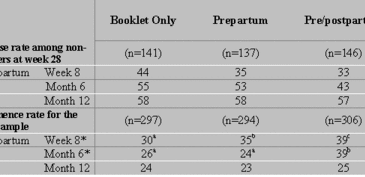Smoking increases a person’s risk for lung cancer as well as a variety of oral and other cancers. Smoking doubles a person’s risk for stroke and coronary heart disease, and it increases a person’s risk for respiratory diseases (Center for Disease Control, 2004a). Because of these and other life-impairing and life-threatening consequences, it is recommended that all current smokers quit smoking. Arguably, it is even more important to encourage pregnant women to cease smoking: mothers and mothers-to-be impair not only their own health, but the health of their child. For example, smoking during pregnancy is associated with low birth-weight, and increases the chance of stillbirth and infant mortality (Center for Disease Control, 2004b). Further, children exposed to environmental smoke from birth have a heightened risk of experiencing consequences due to smoking because of increased exposure. Unfortunately, 17.3% of pregnant women aged 15-44 reported past-month smoking in the 2002 National Survey on Drug Use and Health (Center for Disease Control, 2004c). This week, ASHES reviews a study by McBride, Curry, Lando, Pirie, Grothaus, and Nelson (1999) that tested the efficacy of three brief smoking relapse prevention interventions on new mothers.
The researchers recruited 897 participants from two managed care organizations. Eligible women had to self-report being either a current smoker or a recent quitter (i.e., a person who had smoked in the 30 days prior to pregnancy, but who quit before the baseline survey). Investigators mailed baseline surveys to new prenatal patients at the two clinics who were fewer than 20 weeks pregnant and who met the study inclusion criteria.
McBride et al. randomly assigned these two self-reported smoking groups to one of three experimental groups: (a) self-help booklet; (b) self-help booklet plus relapse prevention booklet and three prepartum telephone counseling sessions (the first call was made two weeks after the booklet was mailed, and the last two calls were made at one-month intervals); or (c) self-help booklet plus relapse prevention booklet, three prepartum and four postpartum telephone counseling sessions (the first call was made within four weeks of delivery, and the second and third calls were made at 4-6 week intervals; all calls were made within the first 4 months postpartum). For all groups the authors assessed smoking behavior via telephone at 28 weeks of pregnancy and three postpartum intervals: 8 weeks, 6 months, and 12 months. Response rates were high: 92% at 28 weeks of pregnancy, 91% at 8 weeks, 89% at 6 months, and 87% at 12 months postpartum.

Figure. Postpartum Smoking Outcomes (%) by Intervention Group (adapted from McBride et al., 1999). Click image to enlarge.
Note: n = number of participants; * = differences among groups significant at p < .05. Groups with different superscripts were significantly different at p < .01. Ns vary slightly due to missing data for some groups/time periods. Relapse was defined as smoking any cigarettes in the previous 7 day. This analysis was limited to participants who reported that they had not smoked in the 7 days before the 28 week follow-up (n=438). Abstinence was defined as having smoked no cigarettes in the previous 7 days and the analysis of this outcome included all participants (n=897).
Analyses of the effects of smoking status (smoker versus recent quitter), site (Seattle or Minnesota) and baseline characteristics on outcomes indicated that the outcomes adjusted for these effects and the unadjusted outcomes were similar. The original study and this review both present unadjusted proportions. As shown in the Figure, nearly half (47%) of the pregnant women were not smoking at week 28 of their pregnancies. The rate at which these women returned to smoking did not differ among experimental groups at any postpartum follow-up period. The experimental conditions did produce significantly different rates of abstinence at week 8 and month 6. At week 8, each experimental group was significantly different from the others and the rate of mothers who abstained from smoking increased with the level of intervention (i.e., lowest rate of abstinence with booklet only group; highest rate of abstinence with pre- and postpartum counseling group). At month 6, the booklet only group and the prepartum counseling group did not differ from each other, but both had significantly lower abstinence rates than mothers who received post-partum telephone counseling. Twelve months after delivery the level of intervention was unrelated to abstinence.
These results suggest that brief interventions might be useful tools for promoting smoking cessation among pregnant women for the first months postpartum. To illustrate, in this study more extensive intervention was related to more abstinence during the first six months postpartum. At the end of one year, however, differences in interventions were unrelated to relapse. Continuing counseling sessions past 4 months postpartum might lead to higher abstinence rates for new mothers, as well as placing more emphasis on the dangers of second-hand smoke to babies and children. The difficulties that these mothers experienced trying to quit—when they had such important reasons to stop—reveal just how complex it is to stop smoking. More research is necessary to identify the beneficial components of quitting interventions, and to determine the best way to help mothers who can abstain from smoking during pregnancy and soon after delivery to continue abstaining from smoking thereafter.
–Siri Odegaard.
References
Center for Disease Control. (2004a). Health effects of cigarette smoking: Fact sheet, Tobacco Information and Prevention Source (TIPS). http://www.cdc.gov/tobacco/factsheets/HealthEffectsofCigaretteSmoking_Factsheet.htm.
Center for Disease Control. (2004b). Smoking Harms Reproduction, Tobacco Information and Prevention Source (TIPS). http://www.cdc.gov/tobacco/sgr/sgr_2004/consumerpiece/page5.htm.
Center for Disease Control. (2004c). Women and tobacco: Fact sheet, Tobacco Information and Prevention Source (TIPS). http://www.cdc.gov/tobacco/factsheets/WomenTobacco_Factsheet.htm.
McBride, C. M., Curry, S. J., Lando, H. A., Pirie, P. L., Grothaus, L. C., & Nelson, J. C. (1999). Prevention of relapse in women who quit smoking during pregnancy. American Journal of Public Health, 89(5), 706-711.
What do you think? Please use the comment link below to provide feedback on this article.




